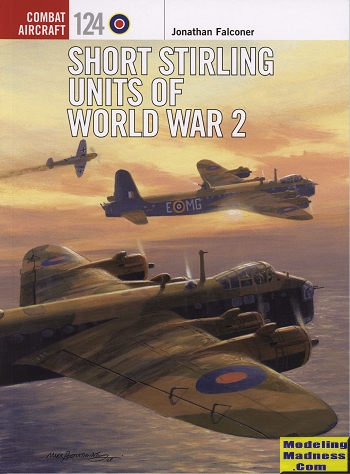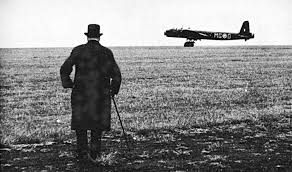 The
Short Stirling is often forgotten when it comes to British WW2 bombers. This is
despite the iconic photo of Winston Churchill
The
Short Stirling is often forgotten when it comes to British WW2 bombers. This is
despite the iconic photo of Winston Churchill
 watching
a Sterling taking off. The Sterling has the honor of being the UK's first four
engine monoplane bomber and it certainly was a plane that was needed. At least
so it seemed to the RAF. However, it was penalized by a couple of things. One is
that it had to fit into current hangars, limiting its wingspan to 99 feet.
Current hangers had a 100 foot opening. Second is that its bomb bay was split
into three sections longitudily. This limited the size of the bomb it could
carry to 2,000 pounds.
watching
a Sterling taking off. The Sterling has the honor of being the UK's first four
engine monoplane bomber and it certainly was a plane that was needed. At least
so it seemed to the RAF. However, it was penalized by a couple of things. One is
that it had to fit into current hangars, limiting its wingspan to 99 feet.
Current hangers had a 100 foot opening. Second is that its bomb bay was split
into three sections longitudily. This limited the size of the bomb it could
carry to 2,000 pounds.
The short wing span meant rather high wing loading. The plane required a
longer than normal take off run. It also limited its altitude to about 16,000
feet, which really wasn't high enough to escape enemy anti-aircraft. Even then
it could not reach that altitude with a full bomb and fuel load. The plus side
is that gave the aircraft a very good roll rate. When the plane was empty of
bombs and had a lightened fuel load, it could out turn all German tactical
aircraft of 1940 except the 109.
The aircraft also had issues with the landing gear collapsing. In fact
the first flight of the prototype ran into this issue. The relatively slow
introduction of the type in service due to a myriad of issues that needed to be
corrected was not something that made the RAF happy and when units were forced
to start operations, the number of planes involved were generally miniscule.
By 1943 it as pretty much out of the bombing business. However, it was
put into a role for the tye plane excelled and that was paratroop transport and
glider tug. When the original specifications were drawn up, it was intended for
it to be able to carry 24 fully equipped troops. Indeed, in the major British
paratroop drops of WWII, it wasn't the Dakota that did most of the work, it was
the Sterling. Once the war was over, the type was quickly scrapped and by late
1946, few were still around.
We are provided the history of the plane's development, its squadron use
as a bomber and then its use as a tug/transport. We are also provided with the
differences between the variants. As usual, there are some great period
photographs and some excellent full color profiles of the various types and
squadrons. It makes for a very well done book on this type and one that I know
you will enjoy reading as much as did I. .
the
Spanish Civil War along with its overseas sale. This then develops into the
various operations of bomber units during the progress of the war. This is
divided into three major segments covering the Mediterranean, North Africa, and
East Africa. There are tons of great period photos as well as the usual fine
full color profiles we expect from this series. It all makes for a superb look
at this important Italian bomber and is one that I can easily recommend to you.
March 2018
Copyright ModelingMadness.com. All rights reserved.
For more on the complete line of Osprey books,
visit www.ospreypublishing.com
If you would like your product reviewed fairly and
fairly quickly, please
contact the editor or see other details in the
Note to
Contributors.
 The
Short Stirling is often forgotten when it comes to British WW2 bombers. This is
despite the iconic photo of Winston Churchill
The
Short Stirling is often forgotten when it comes to British WW2 bombers. This is
despite the iconic photo of Winston Churchill
 watching
a Sterling taking off. The Sterling has the honor of being the UK's first four
engine monoplane bomber and it certainly was a plane that was needed. At least
so it seemed to the RAF. However, it was penalized by a couple of things. One is
that it had to fit into current hangars, limiting its wingspan to 99 feet.
Current hangers had a 100 foot opening. Second is that its bomb bay was split
into three sections longitudily. This limited the size of the bomb it could
carry to 2,000 pounds.
watching
a Sterling taking off. The Sterling has the honor of being the UK's first four
engine monoplane bomber and it certainly was a plane that was needed. At least
so it seemed to the RAF. However, it was penalized by a couple of things. One is
that it had to fit into current hangars, limiting its wingspan to 99 feet.
Current hangers had a 100 foot opening. Second is that its bomb bay was split
into three sections longitudily. This limited the size of the bomb it could
carry to 2,000 pounds.